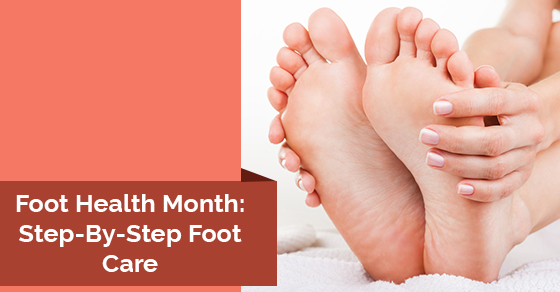Osteoarthritis Treatments: What You Need to Know...
Key Highlights: Osteoarthritis treatments focus on pain relief, restoring joint…
Read More
Posted by Dr. Scott Wilson | 14-May-2018
Foot health is more important than you think. When something goes wrong with your feet, it can affect your whole body. We bear the weight of our bodies on our feet and if left untreated, foot problems can lead to major health issues. By neglecting your foot health, you are basically neglecting your overall health. If it hurts to walk around, it will ruin your quality of life. Activities that you once loved, will become taxing and painful and you’ll become inactive. A sedentary lifestyle caused by foot ailments can be corrected if you care for your feet.
Step-by-step foot care: Show your feet some love
As it’s now Foot Health month, there are things you can do on your own to ensure that are taking care of your feet regularly. The more you do for your feet now, the better you’ll feel as you get older.
Step 1: Wash your feet daily
Even if you wear shoes and socks, you still need to wash your feet every day. You can do it when you’re in the shower or bath or in the sink. You can also buy a small foot bath to cleanse your feet in – whatever works best for you.
Using a gentle soap, wash your feet thoroughly in warm water. Ensure that the water isn’t scalding hot but comfortable enough so that your feet aren’t bright red when you’re done washing them. You can use a washcloth or your bare hands to wash your feet, as long as your hands or the washcloth are clean. Wash between your toes, your heels, arches and ankles.
If you suffer from corns or calluses, rub them gently with a pumice stone until they are smooth. This may not happen during one foot washing session so be patient and try again the next time you clean your feet. Furthermore, some corns and calluses have built up for too long and you may require the help of a professional to remove them.
After washing your feet, dry them well. Make sure to get the areas between your toes. When you don’t properly dry your feet, moisture can collect leading to conditions like athlete’s foot and fungus. You can also rub a thin coat of specially designed foot lotion (ask your doctor or foot specialist which brand they recommended). Ensure that the lotion is spread over the top and bottom of your feet but avoid the spaces between your toes. Again, this could lead to moisture collection and fungal infections.
Step 2. Pedicures and nail care
Getting pedicures and caring for your nails play a big role in the overall health of your feet. You can trim your own toenails weekly (or as needed). When trimming, cut straight across and file the edges with a nail file or emery board. Every six weeks or so you can get a professional pedicure. This can be a very soothing experience as some salons provide foot massages and grooming services that go beyond what you can do for yourself at home.
Things to remember about getting a pedicure:
Cheaper isn’t always better. A lower priced nail salon may not offer the best pedicure. Do your research, read reviews online and make sure you are visiting a reputable salon for treatment.
Look for certifications. Ask the nail technicians where they went to school and how long they’ve been working in the field.
Ask your physiotherapist or doctor is there is a pedicurist they recommend.
At the nail salon, make sure the tools are sterilized and the footbath is emptied and cleaned after each customer.
Step 3. Custom orthotics
Custom orthotics are biomechanical medical devices that are designed to fit the exact contours and shape of your feet. If you suffer from foot ailments, your doctor may prescribe custom orthotics to help improve your gait, restore proper leg function, ease overstrained muscles and reduce pain. Do not buy orthotics from the drugstore. These are not made for your feet. They are made for every foot and can actually cause more harm to your feet because they are not customized to treat your exact issues.
Step 4. Foot protection
Walking barefoot on your carpet at home is fine but walking barefoot outside is not. Wear shoes and socks when you leave the house and wear flip-flops or water shoes at the beach to avoid stepping on foreign objects that can cut your feet like glass.
In terms of footwear, wear something comfortable that matches the activity you are doing. For instance, you wouldn’t wear high heels to go hiking or running shoes to bed. Also, make sure you are wearing appropriate footwear that is sized correctly. Shoes that are too big or too small will have a negative effect on your feet, posture and gait.
Step 5. Circulation is key
In order to ensure that your feet are getting enough oxygen, blood needs to flow properly to your feet. To keep up proper circulation wiggle your toes and move your ankles up and down for about five minutes a day. You should put your feet up when you are sitting down and try not to cross your legs for lengthy time periods. Moreover, smoking hinders circulation. If you smoke, it’s time to quit. Smoking cessation can be tricky but once you’ve mastered it your feet (and lungs) will feel better.
Step 6. Consult your physician
If you notice anything out of the ordinary with your feet, talk to your doctor. Your physician will examine your feet and can diagnose the problem on the spot if it’s minor or send you to a specialist for more complex issues. You should also contact your physician if a cut, blister, sore or bruise on your foot doesn’t start to heal after a day or two. Furthermore, some foot injuries do not cause pain and you may not know that you have a problem until you go to the doctor.
If you are able to maintain your overall foot health, you’ll reap the benefits of a healthy and active lifestyle. Contact Physiomed today to learn more.

Key Highlights: Osteoarthritis treatments focus on pain relief, restoring joint…
Read More
Key Highlights: Runner's knee, or patellofemoral pain syndrome, is a…
Read More
Key Highlights: Upper back and neck pain can be caused…
Read More
Key Highlights: Many people want to lose belly fat for…
Read More
Key Highlights: Vestibular physical therapy, or physiotherapy, is a specialized…
Read More
Key Highlights: Tennis elbow, or lateral epicondylitis, is a condition…
Read More